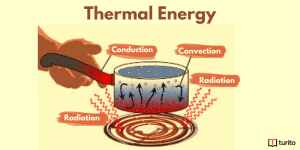What is Electrostatic Potential?
An object possesses electrostatic potential energy by virtue of two elements which are its relative position with respect to other electrically charged objects and the charge possessed by it. The magnitude of the electrostatic potential depends on the amount of work gone into moving the body against the electric field from one point to another.
As we move a body against the electric field, a gain of some amount of energy occurs, which is called electrostatic potential energy. The electrostatic potential energy for any charge is obtained by the division of the electrostatic potential energy by the magnitude of charge.
A positive charge’s potential energy rises when it moves in opposition to an electric field and falls when it goes in that direction; the opposite is true for a negative charge. The unit charge’s potential at any given point is independent of the path followed unless it crosses a magnetic field that is changing.
Electric Potential Energy
Potential energy is the ability to perform work resulting from position or arrangement. In the case of electricity, a charge will exert a force on any other charge, and any collection of charges will result in potential energy. For instance, every other positive charge that is brought close to a fixed positive charge Q in space will suffer a repulsive force and so have potential energy. Near this source charge, a test charge q will have the following potential energy:

where k is the constant of Coulomb.
Utilizing the electric potential energy per unit charge, also known as electric potential or voltage, is typically more practical in the world of electricity.
Electric Potential Formula
The system’s electric potential energy is determined by the formula below:
![]()
where d is the separation between the two charges, q1 and q2, respectively.
What is electrostatic potential energy?
The electrostatic potential energy of a particular charge or a system of charges is defined as the amount of work an external agent does while bringing that particular charge or a system of charges to the present configuration from infinity without undergoing any acceleration.
Definition of electrostatic potential energy:
The electrostatic potential energy is defined as the total potential energy possessed by a unit charge if it is located at a point in outer space.
The electrostatic potential energy is a scalar quantity having only magnitude without a direction. We can measure it in the units of Joules, which is represented by V. Its dimensional formula is ML2T-3A-1
Electrostatic Potential
Represented by V, ∆V, U, ∆U
Dimensional formula: ML2T-3A-1
Normal formula: Voltage = Energy/Charge
SI Unit of electrostatic potential: Volt
The electrostatic potential energy of an object depends upon two key elements— the electric charge it has and its relative position with other objects that are electrically charged.
The formula of electrostatic potential:
Potential energy is possessed by a charge resting in an electric field which is measured by the work done while the charge is moved from infinity to a certain point opposing the electric field. If we separate two charges q1 and q2 from each other by a distance d, the systems electrostatic potential energy is given by:
U = [1/(4πεo)] × [q1q2/d]
If we bring two charges ( two electrons or protons) close to each other, there is an increase in the electrostatic potential energy of the system. If we bring two unlike charges (an electron and a proton) close to each other, there is a decrease in the electrostatic potential energy of the system.
The electrostatic potential at a particular point around a point charge q can be given by:
V = k × [q/r]
Here,
V stands for the electrostatic potential energy
r stands for the distance between a particular point surrounding the charge to the point charge
q stands for the point charge
k stands for the Coulomb constant, whose value is equal to 9.0 × 109 N
Between two arbitrary charges q1 and q2 that are separated from each other by a distance r, the electrostatic potential is given by Coulomb’s law that can be mathematically given as:
U = k × [q1q2/r2]
Here,
U represents the electrostatic potential energy
q1 and q2 represent the two charges
Please note that the electrostatic potential at infinity equals zero (as in the above formula, r = ∞ )
Derivation of the electrostatic potential:
Consider charges q1 and q2 placed at a distance r from each other. The charges’ total electrostatic potential is defined as the total work performed by an external force to bring the charges to a given point from infinity. It can be written as,
-∫ (ra→rb) F.dr = – (Ua – Ub)
We can observe here that the point rb is located at infinity, while the point ra is r.
The above formula can be rewritten after substituting the values as,
-∫ (r →∞) F.dr = – (Ur – U∞)
As infinity equals zero,
-∫ (r →∞) F.dr = -UR
If Coulomb’s law is used between the two charges, the following can be written:
⇒ -∫ (r →∞) [-kqqo]/r2 dr = -UR
Or, -k × qqo × [1/r] = UR
Hence, UR = -kqqo/r
Electrostatic potential of a point charge
Consider two point charges q and Q in the presence of each other with a distance of infinity between them.
UE (r) = ke × [qQ/r]
Here, ke = 1/4πεo = Coulomb’s constant
Consider a point charge q separated from several other points charges Qi with an infinite distance between them.
UE (r) = ke q × ∑ni = 1 [Qi /ri]
Electrostatic Potential for Multiple Charges
For three charges:
Considering three charges, q1, q2, and q3, located at vertices of a triangle, the electrostatic potential energy of this system is given by:
U =U12 + U23 + U31 = (1/4πεo) × [q1q2/d1 + q2q3/d2 + q3q1/d3]
For four charges:
Considering four charges, q1, q2, q3, and q4, located at the corners of a square, the electrostatic potential energy of this system is given by:
U = (1/4πεo) × [(q1q2/d) + (q2q3/d) + (q3q4/d) + (q4q1/d) + (q4q2/√2d) + (q3q1/√2d)]
A Special Case:
Consider a charge Q, in the field of which a charge q is dragged against the electric field between distances a and b from Q. The total work done can be given by :
W = (Vb – Va) × q = [1/4πεo × (Qq/b)] – [1/4πεo × (Qq/a)] = Qq/4πεo[1/b – 1/a] = (Qq/4πεo)[(a-b)/ab]
Important Points
At a midway point between two opposite and equal charges, the electrostatic potential energy is equal to zero. However, the electric field is not equal to zero.
At a point, the electrostatic potential is said to be equal to one volt if we consider one joule of work performed to move 1 Coulomb of the charge against the electric field.
If we move a negative charge from point A to point B, there is an increase in the electrostatic potential of the system.
The reference level employed to describe the electrostatic potential at a point is equal to infinity. The force on a test charge at the reference level is signified as zero.
The Earth’s surface is considered to be at zero potential as it is so huge that the addition or removal of a charge will not lead to an alteration of its electrical state.
What is Electric Potential Difference?
The potential difference E between two points in an electrical circuit can be defined as the amount of work done by an external agent to be able to move a unit charge Q between two points.
In mathematical terms,
E = W/Q
Here,
W stands for work done while moving a charge between two points
E stands for the electrical potential difference between the two points
Q represents the quantity of charge in Coulombs.
Solved Problems on electrostatic potential:
Q1: Consider an object with a mass of 40 mg carrying a charge equal to 5×10-9 C moving in the direction of a fixed positive point charge with a magnitude equal to 10-8 C. When there is a distance of 10 cm between the object and a fixed point charge, its velocity is equal to 50 cm/s. Calculate the distance charge at which the object momentarily comes to rest from the fixed point charge. Determine if the acceleration is constant during the motion or not.
Solution: Suppose the object comes to rest momentarily when there is a distance r between it and the fixed charge; from the law of conservation of energy, we can say:
The total energy of the system = Constant
(K.E + P.E) = constant
(1/2)mu2 + 1/4πεo × [Qq/a] = (1/4πεo) × [Qq/r]
If we substitute the given information in the formula above, we can write:
1/2 × 40 × 10-6 × 1/2 × 1/2 = 9 × 109× 10-8 × 5 × 10-9 × [ 1/r – 1/(10 × 10-2)]
or, [1/r – 10] = (5×10-5)/(9×5×10-8)= 100/9
or, 1/r = (100/9) + 10 = 190/9 m
or, r = 4.7 × 10-2 m
As, F = [1/4πεo] × [Qq/r2]
So, acceleration can be given by F/m ∝ 1/r2
Therefore, we determine that the acceleration is not constant in this case.
Q2.Consider a ball of charge 10-7 C and a mass of 5 grams with a potential of 500 V that moves from a point to point B with a potential of zero. Calculate the ball’s velocity at point A if it is 25 cm at point B.
Solution: Suppose the velocity of the ball at point A is u.
Work performed by the field on the charge:
W = q × (VA – VB) = 10-7 × (500 – 0) = 5 × 10-5 J
The kinetic energy here is increased.
Therefore, W = (1/2) mv2 – (1/2) mu2
5 × 10-5 = (1/2) × 5/1000 [(1/4)2 – u2]
2 × 10-2= 1/16 – u2
u2 = (1/16) – 0.02
= (1- 0.32)/16
= 0.0425
Hence, u =0.206 m/s = 20.6 cm/sec.
And, u = 20.6 cm/sec.
Conclusion
Frequently Asked Questions (FAQs)
1.What is Electrostatic Potential Energy?
The definition of electrostatic potential energy is the total potential energy a unit charge has if it lies at a point in outer space.
2.Give a few examples of electrostatic potential energy.
Examples of electrostatic potential energy include:
- A switched-off incandescent light bulb
- A radio tower that is non-functioning
- Prior to switching the headlights of your car
- A switched-off phone

Relevant Articles
Understanding Thermal Energy: What It Is and How It Works
Thermal energy is essential to our daily lives, from warming …
Understanding Thermal Energy: What It Is and How It Works Read More »
Read More >>Avogadro’s Number: Meaning, Importance, and More
Introduction The concept of measuring the microscopic particles that make …
Avogadro’s Number: Meaning, Importance, and More Read More »
Read More >>Kinetic Friction – Definition, Laws, Types
Kinetic Friction Kinetic force is a force acting between two …
Kinetic Friction – Definition, Laws, Types Read More »
Read More >>Blogs
Is 34 a Good ACT Score? How Can I Improve It?
Let’s look at the average ACT score you’ll need for a great application and how you may improve it.
How Much Do AP Tests Cost? Everything You Need to Know
Students may be eligible for both types of rewards based on their AP exam scores and the college’s policies.
Best Online Coding Classes For Kids
Coding has become a vital piece of a kid’s education and a wonderful opportunity for them to display their creativity and ingenuity.
















Comments: